THE BOUNDARY TRAIL NATIONAL HERITAGE REGION
In 1998, Canada’s national heritage foundation, “Heritage Canada”, established the National Heritage Regions Program to facilitate the establishment of a country-wide network of distinctive heritage areas. The objective of the program is to help partner regions revitalize their communities ecologically, culturally, economically and socially by promoting individual regions unique mix of heritage resources.
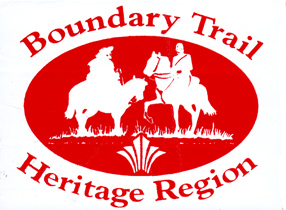
The Boundary Commission – North West Mounted Police (NWMP) Trail Association was organized informally at a meeting at Cartwright, Manitoba on April 30, 1988. The meeting was organized by the Post Road Heritage Group, an association of people from the Emerson area interested in the accurate marking of the 1874 North West Mounted Police trail through western Canada. The Boundary Commission NWMP Trail Association was formally organized at its first Annual General Meeting on 15 April 1989, at Killarney.
The Association’s goal was the promotion of a network of southern Manitoba trails, collectively known as the Boundary Commission NWMP Trail, as a focal point for the history and heritage of southern Manitoba. At its meeting at Killarney on September 14, 1991, the Association passed a resolution requesting Heritage Canada designate the 12 rural municipalities of southern Manitoba between the Red River and the Saskatchewan border as a national heritage region. Heritage Canada evaluated and accepted the proposal, officially designating the Boundary Trail Heritage Region at a ceremony on June 25, 1993 at Clearwater, Manitoba. In December 1993, a new, and larger Boundary Commission NWMP Trail Association board of directors was elected and an appropriate constitution prepared and adopted. At the time of its establishment, the Boundary Trail Heritage Region was the fifth national Heritage Region in Canada and the first in western Canada.
The Boundary Commission NWMP Trail Association‘s constitution identified seven priorities for the Association to pursue to advance its goal:
1. Research – research and precisely locating the route of the Boundary Commission NWMP Trail;
2. Preservation – facilitate the preservation of vestiges of the Trail and the historic sites associated with its history;
3. Development – assist in the appropriate development of these historic sites;
4. Signage – encourage and assist in the erection of appropriate signs and markers for trail remnants and historic sites;
5. Events – support and/or sponsor events to increase public awareness of the location and significance of the Trail;
6. Publications – print and produce such publications and media materials that will increase public awareness of the significance of the Trail to the history and heritage of southern Manitoba;
7. Commemorative Highway Route – Have an appropriate southern Manitoba transportation route officially designated and signed as a commemorative highway, “The Boundary Commission NWMP Route.”
The official naming of the commemorative highway, in conjunction with the Province of Manitoba, took place at Clearwater on 16 July 1991, as part of provincial support for the Association’s bid for national heritage region status. Dignitaries at the ceremony included MLAs Bonnie Mitchelson, Jack Penner, and Bob Rose.
The commemorative route runs from Provincial Trunk Highway (PTH) 75 (PTH 75) near Emerson west along Provincial Road #243 (PR 243) to PTH 32 near Reinland, then north to Winkler. From there, the route runs west a short distance along PTH 14 to where it merges with PTH 3 and then follows Highway 3 the entire distance to Pierson near the Saskatchewan border, as shown on the accompanying map.
By the time of its 6th annual general meeting in 1994, the 12 directors of the Boundary Commission NWMP Trail Association included: Felix G. Kuehn (Winnipeg, President), Harold Carson (Morden, Vice-President), Allen R. Kear (Winnipeg, Treasurer), Douglas J. Morrison (Deloraine), Robert B. Caldwell (Deloraine), Wayne Arseny (Emerson), Elmer D. McClelland (Emerson), Frank Ptosnick (Morden), Ben Kroeker (Deloraine), Henry H. Newton (Brandon), Richard Remus (Emerson, Post Road Heritage Group), and Ronald S. Brown (Brandon, Manitoba RCMP Veterans Association). These individuals were the prime ‘movers and shakers’ for the Association during its active early years.
Throughout the 1990s and early 2000s, Association initiated several major projects. In addition to route signs and site interpretative materials, it helped to organize and sponsor two wagon train rides along the Boundary Trail route. The first, in 1990, traveled 100 miles from Crystal City to the Souris River. In 1992, over 12 days and nights, a second wagon train travelled 200 miles from the Red River to the Souris River, and continued the following year into southern Saskatchewan. A hard-cover travelogue coffee-table style book about the Manitoba trail rides and the countryside it travelled through, entitled Drawing The Line was published soon after. As well, the Association undertook the publication of a series of six “economy soft-cover” publications. The first series of three publications, called “Meet You on the Trail”, consist of descriptive first-hand recollections and personal journal entries of a selection of early travellers on the Boundary Commission Trail. The volumes also include useful introductory remarks, footnotes, annotations and observations by the Association President and primary historian at the time, Felix Kuehn. The next three publications provide “a treasury of additional information concerning the history and heritage of southern Manitoba”. Digital copies of these publications may be found on the Boundary Trail Heritage Region website. A 28-foot map of the trail highlighting some 170 points of historic interest and a brochure, Guide to the Historic Sites Along the Trail, were also developed
In addition to its many regional initiatives, the Association helped fund heritage projects undertaken by other local heritage groups, such as assisting the RCMP Veterans Association erect a statue of a North West Mounted Police near Emerson. Funding for Association’s operations were provided principally through per capita support by member municipalities and provincial heritage grants. In recent years, operational funding has decreased, due in part to the economic recession resulting from the 2008 stock market collapse and its aftermath. Beginning in 2013, in response to Canada’s approaching 150th birthday and new Board of Directors membership, the Association has reinvigorated itself and is undertaking a new series of projects. Among them is a series of research and illustrated history publications highlighting the region’s unique natural and cultural heritage, and a new expanded website.
Key map of Manitoba
showing the location of the Boundary Trail Heritage Region along the province’s southern border, straddling the United States boundary. (MB Maps & Surveys.)
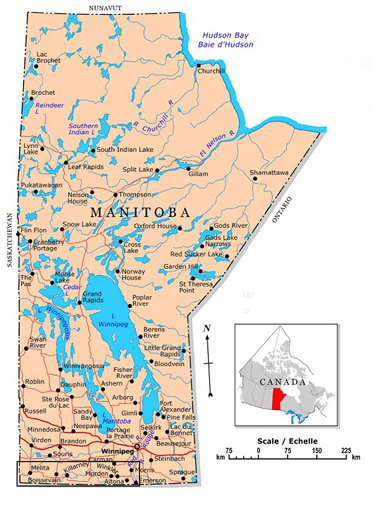
The BC-NWMP Trail Association logo
Depicts the meeting of William Hallett (1811-1873), Chief Scout of the International Boundary Commission and George Arthur French (1841-1921), First Commissioner of the North West Mounted Police. It commemorates their chance meeting on the trail west of Fort Dufferin in 1873. These two notable individuals, associated with two major historical events occurring concurrently in the same region, were chosen to represent, as well as the NWMP and the International Boundary Commission, all the early explorers, fur traders, Indigenous Peoples and early settlers, all of whom traveled extensively on the Boundary Commission trail network at one time or another during its existence.

Cover of one of several pamphlets produced by the Association providing visitor information on sites located the Boundary Trail Heritage Region. (B.T.H.R. files.)
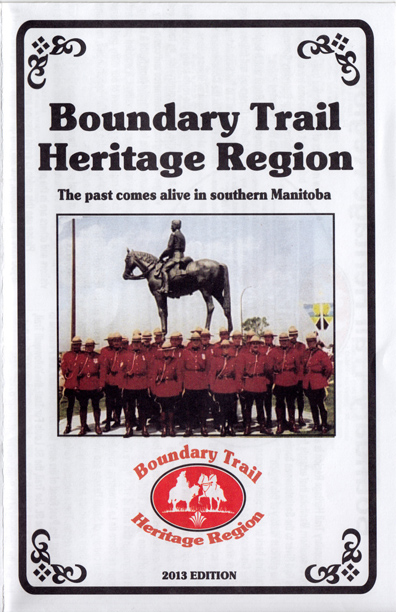
Mural
On the east wall of the Olympic Sports building, 403 Stephen Street, Morden depicting a well known photographic view of a Boundary Commission supply train crossing Dead Horse Creek in 1873. The former crossing was located just south of the present day town site. (BTHR photo.)
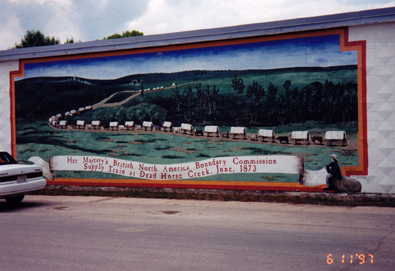
Bill Reimer and Maurice Butler
Association Board members Bill Reimer and Maurice Butler (in NWMP uniform) with a Boundary Trail Heritage Region sign on the exterior of a recreated NWMP outpost constructed by the association at the Pembina Threshermen’s museum near Morden, seen below. (BTHR photo.)
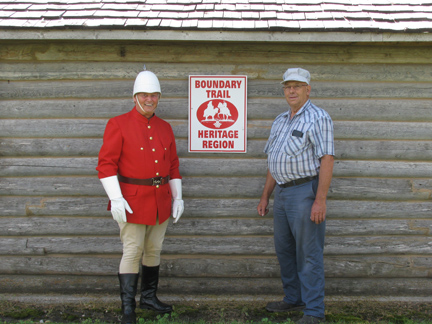
Commemorative Highway Route Signs
Because of petitioning by the Association, the Manitoba Highways designated “The Boundary Commission – NWMP Route” as an official Province of Manitoba Heritage Highway Route. The designation was officially proclaimed on 15 July 15 1991 by the Hon, Harry Enns, Minister of Natural Resources. The following day, the Hon. Bonnie Mitchelson, Minister of Culture, Heritage and Citizenship, officiated at ceremonies in the village of Clearwater. (EdLed photo.)
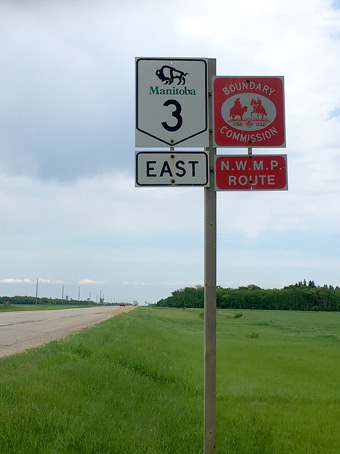
Claybanks Bison Jump
Professionally produced site information kiosks, such as this one located at the Claybanks Bison Jump archaeological site located north of Cartwright, help visitors better appreciate and understand sites that have little or no surviving current remnants. (EdLed photo.)
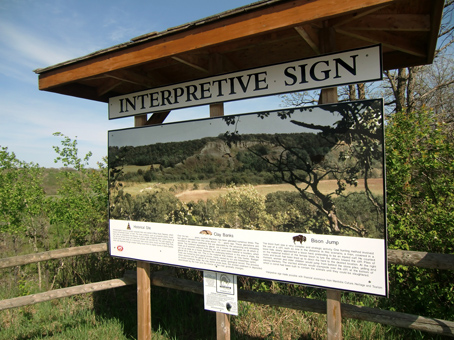
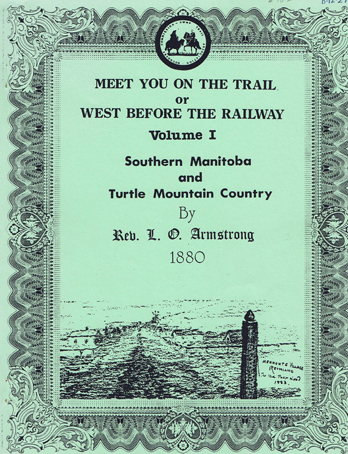
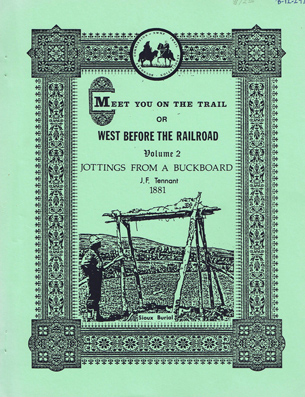
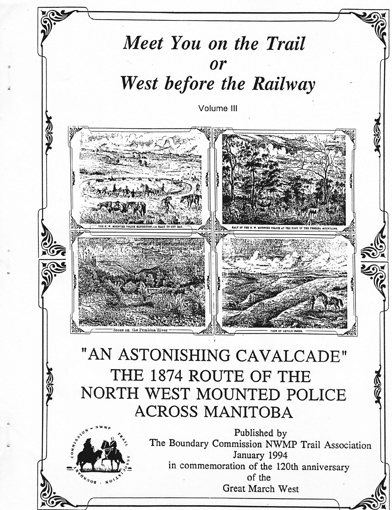
Above. cover pages of three of the six ‘soft cover’ publications produced by the Association during the 1990s. Volume I is a travelogue penned by Rev. Louis Armstrong who preached to some of the earliest homesteaders of the Pembina Hills region and was an active participant in many speculative railway-related real estate dealings in the region. Volume II follows the journal entries of four members on the difficult NWMP 1874 “Trek West” during its first few weeks of this epic journey to the Rocky Mountains to bring law and order to the Canadian west. Publication Six at top right is a guide to the principal sites in the Boundary Trail Heritage Region. (BTHR files.)
Boundary Trail Heritage Region
Map showing the current rural municipalities and incorporated municipalities in the greater Boundary Trail Heritage Region. (MB Maps & Surveys.)
TRAIL ASSOCIATION PUBLICATIONS
Between 1989 AND 1993 THE BOUNDARY COMMISSION NWMP TRAIL ASSOCIATION published seven books focusing upon the history of southern Manitoba. All were researched and/or written and edited by Felix Kuehn, founding president of the Boundary Commission NWMP Trail Association. Most volumes are illustrated and, where applicable, include a biographical sketch of the original author. Additional information about the people, places and events mentioned in the text is provided by the numerous footnotes.by Mr. Kuehn. Three of these form a set entitled MEET YOU ON THE TRAIL OR WEST BEFORE THE RAILROAD and are the first-hand recollections and journals of travellers along the Boundary Commission NWMP Trail during the 1870 and 1880s. This set includes the following volumes:
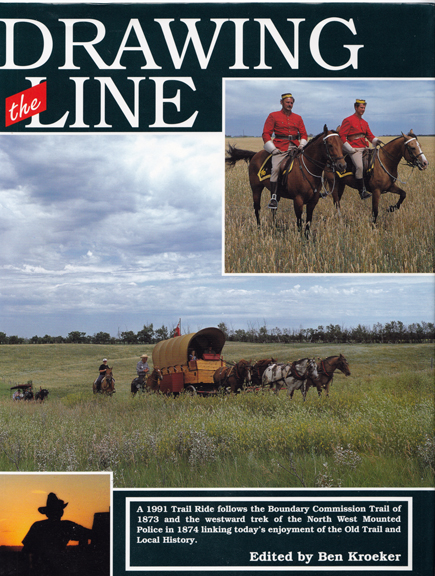
1. SOUTHERN MANITOBA AND TURTLE MOUNTAIN COUNTRY – THREE WEEKS IN WINTER THROUGH SOUTHERN MANITOBA
The author of Southern Manitoba and the Turtle Mountain Country: Three Weeks in Winter through Southern Manitoba, Rev. L.O. Armstrong, rector of St. Lukes Church of England in Emerson, was a key figure in the development of southern Manitoba during the four years when he resided in western Canada. The purpose of the expedition described in this narrative was two-fold. His first intention was to determine the most suitable route for the “Emerson and Turtle Mountain Railroad,” which the town of Emerson planned to build to guarantee its status as “the Gateway City.” He was also anxious to locate possible sites for Church of England settlements in southern Manitoba.
The volume includes a biography of Rev. Armstrong, and a reproduction of his famous map of the route he travelled. This map documents the location of the various pioneer settlements noted in the narrative; West Lynne, Stoddarts, Mountain City, Calf Mountain, Pembina Crossing, Crystal City, Clearwater Village, Badger Creek, Pancake Lake Stopping Place, and La Rivieres.
The illustrations are the work of Rev. Armstrong’s good friend, Mr. R.N. Lea, a pioneer of 1880 at Pembina Crossing. Mr. Lea’s sketches include the only known contemporary illustration of the famous “Post Road” through the West Mennonite Reserve and a drawing of the caboose used by Mr. Armstrong in January 1880. (40 pages)
Southern Manitoba and Turtle Mountain – 1880
2. JOTTINGS FROM A BUCKBOARD FOUR HUNDRED MILES AND THREE WEEKS ON THE TRAIL IN MAY 1881
Jottings from a Buckboard: Four Hundred Miles and Three Weeks on the Trail in May 1881, describes a three-week, four hundred-mile tour of southern Manitoba . In May 1881 Mr. J. F. Tennant, drove from the Red River west to the Souris River, then back to the Turtle Mountains, northeast to the Assiniboine River and then southeast back to West Lynne via Nelsonville. During this May 1881 trek the author visits many of the same places described by Mr. Armstrong and, although only sixteen months have passed, the growth of southern Manitoba pioneer settlement has been spectacular. More than forty well-known settlers in almost two dozen communities are mentioned by name. Originally published in 1881 as a series in the West Lynne Southern Manitoba Times newspaper, because of the wealth of historical information included in this series of articles, portions of Jottings from a Buckboard have been republished several times. However this is the first volume to contain the full text of this fascinating narrative.
It also includes a biography of Mr. Tennant, (a member of the 1870 Wolseley Expedition and one of the earliest settlers of the Emerson district) and an article on the Wolseley Expedition highlighting the role it played in the settlement of southern Manitoba. Numerous notes on the pioneers, places and events mentioned in Mr. Tennant’s text are also provided by Mr. Kuehn. (60 pages)
Jottings From A Buckboard (1881)
3. An Astonishing Cavalcade – The 1874 Route of the North West Mounted Police across Manitoba
Almost half of An Astonishing Cavalcade: The 1874 March of the North West Mounted Police across Manitoba, is a day-by-day itinerary of their trek from Fort Dufferin, the headquarters on the west bank of the Red River two miles north of Emerson, to what is now the Manitoba-Saskatchewan border. Using diaries of several members of the force, Mr. Kuehn follows the footsteps of the NWMP along the Commission Trail on their travels from 8th to 20th July. Biographical articles featuring members of the original force who returned to Manitoba, for example Cartwright pioneer Thomas Mooney, are also included.
Twenty-seven sketches drawn by the well-known artist of Montreal’s Canadian Illustrated News, Henri Julien, illustrate this volume. Although many of these drawings are well known, others are reproduced for the first time since 1874. Among those from southern Manitoba are views of Fort Dufferin and vicinity; the NWMP at the foot of the Pembina Mountains; Dead Horse Creek; cutting hay near Calf Mountain; the Boundary Commission Bridge at Pembina Crossing and the Badger Creek Crossing. One chapter entirely devoted to statistics pertaining to the original force includes a complete listing of the officers and men who particiapted in the 1874 March West and their daily salaries. (80 pages)
The second series, A STORY FOR EVERY MILE, is a rich treasury of additional information compiled and written by Felix Kuehn concerning the history and heritage of southern Manitoba. This set includes the following biographical and historical material:
1. THE BOUNDARY COMMISSION NWMP TRAIL THE GREAT HIGHWAY OF THE SOUTHERN PORTIONS OF THE BRITISH DOMINIONS IN THE FAR WEST – A GUIDE TO THE HISTORIC SITES ALONG THE TRAIL
A Guide to the Historic Sites along the Trail combines an illustrated synopsis of the forty-five principal historic sites along these trails with a series of maps of those portions of Manitoba and North Dakota through which the Trail passes. These historic sites are located in the Townships of PEMBINA, NECHE, FELSON and WALHALLA in the County of PEMBINA, North Dakota and in Manitoba in the Municipalities of FRANKLIN, MONTCALM, RHINELAND, STANLEY, PEMBINA, LOUISE, ROBLIN, TURTLE MOUNTAIN, MORTON, WINCHESTER, BRENDA, ARTHUR and EDWARD. The Boundary Commission NWMP Trail has four components, namely: 1. the route in 1873-74 of the International Boundary over a series of ancient Indian and fur trading trails; 2.the 1874 route of the NWMP; 3. the Post Road across the West Mennonite Reserve; and 4. the Boiler Trail along the foot of the Turtle Mountains. (35 pages)
2. THOU GRAND OLD CHURCH OF ENGLAND…IN THE PEMBINA MOUNTAIN COUNTRY – A HISTORICAL SYNOPSIS WITH SPECIAL REFERENCE TO ST. LUKES PEMBINA CROSSING ON THE BOUNDARY COMMISSION TRAIL
Without question, St. Lukes, Pembina Crossing, located at the ford of the Commission Trail across the Pembina River, is one of the most historic parishes of southern Manitoba. It was, for example, at Pembina Crossing that the first Church of England in southern Manitoba west of the Red River was completed. In the mid 1880s, St. Lukes was the Church of England’s most westerly parish along the border and, in the words of its incumbent at that time, extended to the Rocky Mountains for there were no other parishes to the west of it. The second church in the village, originally served the district as a general store and whiskey saloon. It only became a church after having served as the first school in the community.
Thou Grand Old Church of England … in the Pembina Mountain Country also outlines the establishment of the Church of England in southern Manitoba from the Red River west into the Pembina Mountains. Numerous quotations from pioneer newspapers enrich the text, illustrations include an exterior view of the log church in 1902, a view of the interior decorated for a pioneer Christmas service, selections from the earliest records of the church, and a bird’s-eye view of the townsite of Pembina Crossing used to promote it across the entire Dominion as “the most prosperous town in southern Manitoba.” (40 pages)
3. WHITHER THOU GOEST – THE LIFE AND TIMES OF REV. ANDREW GORDON AND HIS WIFE, ANN COPP GORDON
Whither Thou Goest provides the reader with a priceless insight into the spiritual life of the pioneers of southern Manitoba in the 1880s. Written in a picturesque and highly personal style, this volume is part of a biography of Rev. and Mrs. Andrew Gordon, written by the late Miss Anne Gordon of Winnipeg. It deals with their lives between 1882 and 1887, the period in which they served at Alexandria and Manitou in southern Manitoba.
Both are important historic figures: Rev. Gordon was the second minister of the Bible Christian Church in Manitoba where he served “Manitoba’s first, and only, Bible Christian Church” located on the Boundary Commission Trail six miles southwest of Thornhill. His wife was the first woman minister of a Methodist church in Canada. Rev. Gordon and his wife were the namesake of Winnipeg’s Gordon Methodist Church, now Gordon-King United, one of the city’s most beautiful pre-World War I churches.
The volume includes a family portrait of the Gordons, and an outline of the entire biography of Rev. and Mrs. Gordon as well as a history of “The Establishment of the Methodist Church in the Pembina Mountain Country.” One of the most delightful aspects of this narrative is its graphic descriptions of the beauties of nature, such as winter morning mirages and the acres of prairie wildflowers. It concludes with the final chapters of the original manuscript written by Miss Anne Gordon. (80 pages)
4. ‘TWAS ONCE A TEEMING HIGHWAY’ HISTORIC SKETCHES FROM ALONG THE BOUNDARY COMMISSION TRAIL
The motto chosen for the Boundary Commission NWMP Trail is a “A Story for Every Mile”, a reference to a 1912 newspaper article stating, “the Commission Trail … runs back into the very beginning of the history of the west and has a story for every mile.”
This volume, ‘Twas Once a Teeming Highway, is a rich treasury of these “stories for every mile” recalling the time when, in the words of an 1881 newspaper article, the Trail was “The great highway of the southern portions of the British Dominions in the far west.” These articles cover a wide spectrum of southern Manitoba history in narratives providing insights into the prehistoric period and the romance of early exploration.
A few examples may be mentioned. The hardships encountered by the pioneers are exemplified by a story telling how the wife of a former director of the Bank of Glasgow walked along the Trail for 125 miles from the Red River to the Turtle Mountains. Another recalls the remarkable accomplishments of our settlers; the building of one of southern Manitoba’s most beautiful fieldstone churches in thirty-eight working days. Other tales paint for us an insider’s glimpse into the everyday events of pioneer life that were remembered by the early settlers of southern Manitoba as long as they lived. (100 pages)